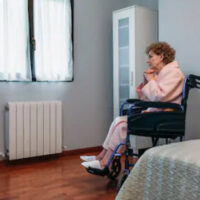The Unlawful Use of Restraints in Nursing Homes

Oklahoma law prohibits the use of both physical and chemical restraints in nursing homes, whether utilized as a form of discipline or convenience for employees. In fact, restraints can only be used in a few specific circumstances, including during emergency situations or for treating medical conditions. Unfortunately, an alarming number of nursing homes violate these rules, leaving residents to suffer from bedsores, inadequate nutrition, a lack of exercise, and psychological trauma. For help holding your own loved one’s nursing home accountable for its unlawful use of restraints, please reach out to our experienced Tulsa nursing home abuse lawyers today.
Physical and Chemical Restraints
Physical restraints are meant to render a person helpless by restricting his or her movement through the use of straps, ropes, and even physical force. Nursing homes are generally cautioned against using these types of restraints on residents, as they can result in serious injuries and trauma. They are, however, permitted in some cases, including when residents have become a danger to themselves or others.
Physical restraints are not the only means by which nursing home employees restrict the movement of residents. In fact, the use of chemical restraints is often more common in nursing homes, as they do not result in the same kinds of physical evidence, but involve the use of drugs to sedate a person. Although chemical restraints can legally only be used in emergency situations and acute psychiatric settings, many nursing homes use sleep-inducing, anti-anxiety, and muscle-relaxing sedatives for other reasons, including to restrain troublesome or unruly patients. Unfortunately, using restraints in these situations can do more damage than good, causing bedsores, delirium, asphyxiation, cognitive impairment, chemical dependence, alterations in mood behavior, unconsciousness, and even death.
Rules Regarding Acceptable Restraint Use
Even if the use of either physical or chemical restraints is appropriate in a specific case, a physician must still consent to their use. The only exceptions to this rule apply in cases where using restraints is necessary as an injury prevention method and after attempts at other methods have failed. Even in these cases, any physical restraints must be utilized only by a licensed nurse. Furthermore, all physical restraints must allow for quick release, while the use of locked restraints is totally prohibited. Nursing homes can also use restraints during emergency situations that require the use of restraints to ensure the safety of the resident, other residents, or staff members.
If the use of restraints is necessary in a certain situation, nursing home employees must abide by strict rules regarding monitoring and supervision. For instance, when restrained, residents must be continually monitored and must also be released for at least ten minutes every two hours. Restrained residents should also be exercised, repositioned, and be assisted with bathing and using the restroom as necessary. Nursing homes that fail to comply with these laws can be held liable for resulting injuries.
Legal Case Review
Nursing homes can and should be held accountable for their failure to provide proper care to residents. Please reach out to the experienced Tulsa nursing home abuse attorneys at Levinson Law, P.C. by calling 918-492-4433 to learn more about your loved one’s own legal options after suffering abuse at the hands of a nursing home staff member.
Resource:
ok.gov/health2/documents/675.pdf

